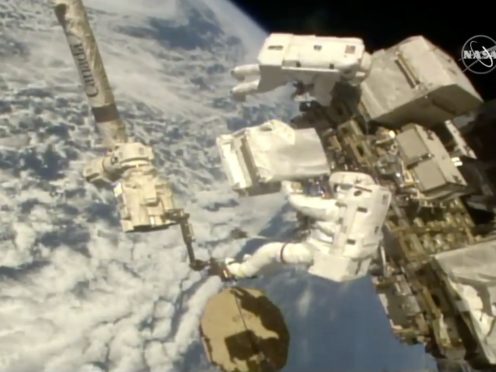Two of this year’s Nobel laureates have held a video call with two members of the International Space Station’s crew.
The Friday call was part of the public appearances of winners in the Swedish capital ahead of next week’s prize presentations.
After the crew took some questions from winners of the physics and chemistry prizes, Italian astronaut Luca Parmitano asked if any of them would switch places with him.
Didier Queloz and M. Stanley Whittingham said they would.
LIVE: Incoming call…from space! @Astro_Jessica of @NASA_Astronauts & @astro_luca of @ESA speak with @NobelPrize winners in physics & chemistry from the @Space_Station.
Start your day w/ talks on exoplanets, the Universe & tech that improves life on 🌎! https://t.co/28zXPS2fOC
— NASA (@NASA) December 6, 2019
“Nothing prevents an astronaut to get another prize,” Mr Queloz quipped.
Mr Whittingham, 77, said he would have switched places if he were younger.
Mr Queloz and Michel Mayor, who was also on the ISS call, share this year’s prize worth nine million kronor (945,000 US dollars) for discovering the first extra-solar planet orbiting a sun-like star.
Mr Queloz asked the astronauts about how they viewed the prospects of finding life elsewhere in the universe.
"What is your advice to young students with a passion for space science and exploration?"– Nobel Laureate Michel Mayor (centre left)
"Stay curious!"– Astronaut Luca Parmitano (far right) during a call from our 2019 Nobel Laureates to space today! pic.twitter.com/ALkDns9Tpk
— The Nobel Prize (@NobelPrize) December 6, 2019
“We would be very naive statistically to think that there is no life on other planets,” said US astronaut Jessica Meir.
“One of the interesting things about it is that life might not look anything like us; it might not even be carbon-based.”
Mr Whittingham is one of the three winners of this year’s chemistry Nobel for development of lithium-ion batteries.
The batteries were praised by Ms Meir, who noted that they have been recently installed on the space station, replacing nickel-hydrogen batteries for “significant performance advantages”.
One lithium-ion battery can replace two of the previous batteries and last 10 years instead of six and a half years, she said.
